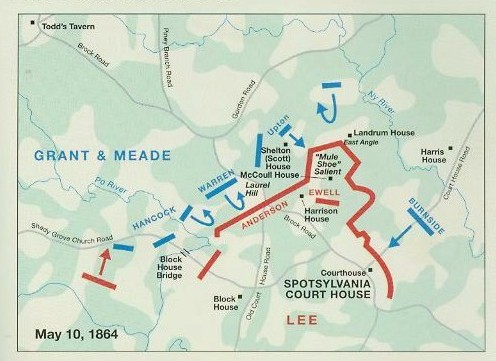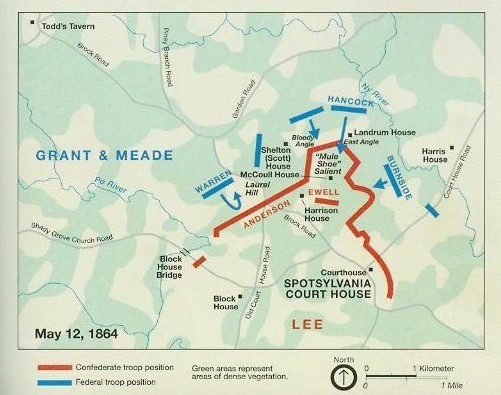![]()
After the Wilderness, Grant's and Meade's advance on Richmond by the left flank was stalled at Spotsylvania Court House on May 8. This two-week battle was a series of combats along the Spotsylvania front. The Union attack against the Bloody Angle at dawn, May 12-13, captured nearly a division of Lee's army and came near to cutting the Confederate army in half. Confederate counterattacks plugged the gap, and fighting continued unabated for nearly 20 hours in what may well have been the most ferociously sustained combat of the Civil War. On May 19, a Confederate attempt to turn the Union right flank at Harris Farm was beaten back with severe casualties. Union generals Sedgwick (VI Corps commander) and Rice were killed. Confederate generals Johnson and Steuart were captured, Daniel and Perrin mortally wounded. On May 21, Grant disengaged and continued his advance on Richmond.
Result(s): Inconclusive (Grant continued his offensive.)
Other Names: Combats at Laurel Hill and Corbin's Bridge (May 8); Ni River (May 9); Laurel Hill, Po River, and Bloody Angle (May 10); Salient or Bloody Angle (May 12-13); Piney Branch Church (May 15); Harrison House (May 18); Harris Farm (May 19)
Location: Spotsylvania County
Campaign: Grant's Overland Campaign (May-June 1864)
Date(s): May 8-21, 1864
Principal Commanders: Lt. Gen. Ulysses S. Grant and Maj. Gen. George G. Meade [US]; Gen. Robert E. Lee [CS]
Forces Engaged: 152,000 total (US 100,000; CS 52,000)
Estimated Casualties: 30,000 total (US 18,000; CS 12,000)
Source:
![]()
Maj. Gen. Richard Anderson led a Confederate column on a parallel route not far to the west of Brock Road. Anderson had assumed command of Longstreet's corps on May 7 and was ordered to have his troops at Spotsylvania Court House before dawn on the 8th. Lee had correctly deduced that the tiny county seat would be Grant's next objective because whoever controlled the Spotsylvania crossroads would enjoy the inside track to Richmond.
Anderson tried to find a bivouac where his men could rest for a few hours before their grueling march south. When he discovered that the fiery Wilderness offered no practical campsites, he put his command in motion without sleep, a fateful decision that saved Spotsylvania for the Confederates.
Warren continued his advance and early on the morning of May 8 spied an open plateau in his front known locally as Laurel Hill. The Federals saw only their nocturnal nemesis, Fitzhugh Lee's pesky cavalry, defending the ridge—no match for infantry in a daylight fight. Warren ordered an attack.
The Maryland Brigade led the Union charge west of the Brock Road, sweeping over the rolling fields with a cheer. As the troops approached to within 50 yards of the Confederate position, they were hit by artillery and rifle fire that dropped them where they stood. This was not dismounted cavalry, but the lead units of Anderson's corps. The Confederates had won the race to Spotsylvania.
The armies flowed onto the battlefield the rest of the day, extending corresponding lines of earthworks east and west of the Brock Road. Ewell's corps filed in on Anderson's right and built their entrenchments in the dark to conform with elevated terrain along their front. First light revealed that Ewell's soldiers had concocted a huge salient, or bulge, in the Confederate line, pointing north in the direction of the Federals. The men called it the "Mule Shoe" because of its shape, but it boded trouble. Salients could he fired into and attacked not only in front hut from both sides, and as a rule officers liked to avoid them. Lee, however, opted to retain the position trusting that his cannoneers could keep the Mule Shoe safe enough.
 Grant probed both of Lee's flanks on May 9 and 10 to no avail. About 6 p.m. on the 10th. a 24-year-old colonel named Emory Upton formed 12 hand-picked regiments along a little woods road opposite the heart of the Confederate defenses. Upton had received permission earlier in the day to assail the west face of the Mule Shoe using imaginative tactics designed to penetrate the salient, then exploit the breakthrough. The
Federals crept to the edge of the woods 200 yards from the Confederate line, then burst into the open field with a yell.
Grant probed both of Lee's flanks on May 9 and 10 to no avail. About 6 p.m. on the 10th. a 24-year-old colonel named Emory Upton formed 12 hand-picked regiments along a little woods road opposite the heart of the Confederate defenses. Upton had received permission earlier in the day to assail the west face of the Mule Shoe using imaginative tactics designed to penetrate the salient, then exploit the breakthrough. The
Federals crept to the edge of the woods 200 yards from the Confederate line, then burst into the open field with a yell.
After overrunning a startled brigade of Georgians, Upton's men seized three guns, a reserve line of works, and almost reached the McCoull House in the center of the Mule Shoe before the Confederates recovered. Southern artillery at the top of the salient stymied Upton's expected support, and a counterattack eventually shoved the Federals back to their starting points. But the boyish colonel's temporary success gave Grant an idea. If 12 regiments could break the Mule Shoe, what might two corps accomplish?
Grant found out on May 12, a day remembered by soldiers from both sides as one of the darkest of the entire war. "I never expect to be fully believed when I tell of the horrors of Spotsylvania," wrote a Federal of his ghastly experience. "The battle of Thursday was one of the bloodiest that ever dyed God's footstool with human gore," echoed a North Carolinian.
 The Confederates set the stage for this waking nightmare on the evening of May 11, when they removed their artillery from the Mule Shoe under the mistaken impression that Grant had quit Spotsylvania. In truth, Hancock's corps spent the rainy night sloshing into position to launch a massive stroke against the top of the salient. That attack began about dawn and succeeded in capturing most of the Mule Shoe and many of its defenders.
The Confederates set the stage for this waking nightmare on the evening of May 11, when they removed their artillery from the Mule Shoe under the mistaken impression that Grant had quit Spotsylvania. In truth, Hancock's corps spent the rainy night sloshing into position to launch a massive stroke against the top of the salient. That attack began about dawn and succeeded in capturing most of the Mule Shoe and many of its defenders.
Ironically, the sheer magnitude of Hancock's victory retarded his progress. Nearly 20,000 of his soldiers milled about the surrendered entrenchments gathering prizes, escorting captives to the rear, and generally losing their organization and drive. This delay provided Lee the opportunity he needed.
The Confederate commander directed his counteroffensive from near the McCoull House. Again Lee attempted to personally lead his troops against the Federals. This time the colorful Georgian, John Gordon, persuaded him to go back before plunging ahead himself. One by one, additional brigades joined Gordon, and by 9:30 a.m. they managed to restore all but a few hundred yards of the original Southern line.
The Union Sixth Corps, commanded by Brig. Gen. Horatio Wright since Sedgwick's death on May 9, now joined the fray, and for the next 18 hours the most vicious and horrifying close-quarters combat ever wit- nessed on the continent spilled the lifeblood of numerous Americans. The fighting focused on a slight bend in the works west of the apex, known to history as the "Bloody Angle."
A shallow valley sliced close to the Confederate line at this point, providing crucial shelter for swarms of Union assailants. An appalling tactical pattern developed here throughout the day. Federals would leave the cover of the forest, cross the lane leading to the Landrum House, and take refuge in the swale. From there they maintained a constant rifle fire and made periodic lunges onto the works at the Bloody Angle.
Two Southern brigades, one from Mississippi and one from South Carolina, bore the brunt of these attacks. They fought behind elaborate log barricades four feet high enhanced by perpendicular traverse walls at 20-foot intervals. The Confederate works resembled three-sided roofless log cabins and their design explains the miraculous endurance of their occupants — that and the heroic desperation of half-crazed men whose world consisted of a tiny log pen filled with rain water and slippery with the mangled remains of comrades and enemies.
The equally intrepid attackers varied their efforts to capture the Angle with an occasional innovation. A section of Union artillery advanced to practically point-blank range, blasting the works, until all of its horses and all but three of its cannoneers had fallen. The men of a Michigan regiment crawled on their stomachs along the outside of the trenches until, at a signal, they leapt over the logs and into a profitless melee with the Rebels.
More often the assaults defied precise definition. The battle assumed an unspeakable character all its own, unrelated to strategy and tactics or even victory and defeat. "The horseshoe was a boiling, bubbling and hissing cauldron of death," wrote a Union officer. "Clubbed muskets, and bayonets were the modes of fighting for those who had used up their cartridges, and frenzy seemed to possess the yelling, demonic hordes on either sidc."
This organized insanity continued past sunset and into the night. Finally about 4 a.m. on May 13, whispered orders reached the front directing the battlenumbed defenders to fall back to a new position at the base of the Mule Shoe. When the Federals cautiously approached the quiet trenches at dawn, they found the Bloody Angle inhabited only by those who could not withdraw. "They were lying literally in heaps, hideous to look at. The writhing of the wounded and dying who lay beneath the dead bodies moved the whole mass ...."
Completion of Lee's last line rendered control of the salient meaningless. Grant shifted his army to its left during days of heavy downpours, searching for a weak spot in the Confederatc line. On May 18 he sent Hancock back to the Mule Shoe, hoping to catch the enemy by surprise. The Southerners were not fooled, however, and by mid-morning Grant canceled the effort.
Clearly, the Federals could not gain an advantage at Spotsylvania, and Grant broke the impasse on May 20 by detaching Hancock's corps on a march south toward Guinea Station. The rest of the Union army followed on the 21st. Lee had no choice but to react to Grant's initiative by maneuvering his army between the Federals and Richmond.
==================
SUMMARY
==================
Losses during the two weeks at Spotsylvania added 18,000 names to Union casualty lists, 10,000 to Confederate. Lee, though, suffered a disproportionate attrition among the highest levels of his command structure. Finding replacements for private soldiers was hard enough; developing a new officer cadre proved impossible. The essence of Lee's incomparable martial machine disappeared in the woods and fields of Spotsylvania County, and the Army of Northern Virginia never regained its historic efficiency.
Grant, however, played no callous game of human arithmetic at Spotsylvania. He sought a decisive battlefield victory that Lee's tenacious, skillful generalship denied him. But in the end, the Federals' constant hammering against the dwindling resources of their gallant opponents, a process begun in the Wilderness and at Spotsylvania and continued at the North Anna River, Cold Harbor, and Petersburg, would finally drive the Confederacy into oblivion.
Source:
Last Updated 10 May 2002
It was the best of times, it was the worst of times
Click on any [Item] below to go to that page
[Return to Glossary Page]
[Return to 43rd Pennsylvania Home Page]

© 1998-2004 Benjamin M. Givens, Jr.
![]()